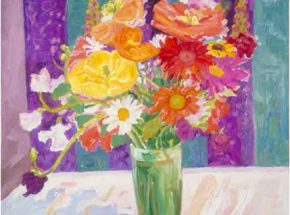

Augustus Vincent Tack is widely recognized as an early modernist whose abstractions anticipate the color field painting of the 1960s and the abstractions of other artists including Milton Avery and later, Clyfford Still. Born in Pittsburgh, Tack moved with his family to New York in 1883. After graduating from college in 1890, Tack studied at the Art Students League until 1895, earning praise from the press for his portraits. He may also have frequented the studio of watercolor and stained glass design innovator, John La Farge, whose portrait he painted around 1900.
Tack spent time in France in 1893, 1895, and possibly 1896, working with a French mural painter. He had his first solo exhibition at the noted Kraushaar Galleries in New York in 1896, and the next year he moved to an artists’ colony in Deerfield, Massachusetts, where he met and later married Agnes Gordon Fuller, daughter of artist George Fuller.
Tack maintained a studio in New York from 1894 until the end of his life. He had frequent exhibitions at New York galleries, and from 1900 until the twenties his work was shown regularly at the Worcester Art Museum, at the Carnegie International exhibitions in Pittsburgh, and at the Pennsylvania Academy of the Fine Arts in Philadelphia. He taught at the Art Student’s League between 1906 and 1910 and at Yale University from 1910 to 1913. About 1914 to 1915 his work attracted the notice of Duncan Phillips, who became his close friend and chief patron. Phillips and Tack also collaborated on the organization of the Allied War Salon of 1918.
Tack’s portraits and murals were traditional in style, but he also painted a number of mystical landscapes and semiabstract works on spiritual themes such as creation. These paintings, subjective and poetic explorations of nature that carried suggestions of timelessness and spirituality, were commercially unsuccessful. Though Tack continued to paint conventional portraits and classically inspired murals for the remainder of his career, his most original achievements remain his semiabstract landscape paintings, many of which were inspired by photographs of the landscape of the American West. These were executed almost exclusively for Phillips. From 1941 on, Tack maintained a studio in Washington, D.C., where he produced portraits of political and military leaders, including Eisenhower and Truman, while he continued to paint his poetic abstractions.
Excerpted from Eye, LF
www.phillipscollection.org/research/american_art/bios/tack-bio.htm
